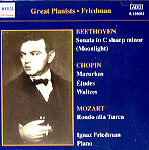Ignaz Friedman’s boundless technique, juicy tone, and larger-than-life temperament truly justify his standing alongside other so-called Golden Age piano legends such as Hofmann, Rachmaninov, Lhevinne, and Moiseiwitsch. Naxos’ long-awaited series devoted to Friedman’s complete recordings makes an auspicious debut with Volume 1. Unlike previous Friedman reissues that mix and match material, Naxos aims to present the recordings in chronological sequence, a game plan that we assume will prevail for the remaining installments. More significantly for collectors, Ward Marston’s exemplary restorations are the finest Friedman transfers since Seth Winner’s for Danacord’s complete Friedman edition issued on LP in 1985.
Indeed, Marston improves upon his work for Pearl’s Friedman series. In the six acoustic sides that open the disc, for example, Marston reduces the surface noise by further increments and achieves an equalization that allows the piano’s full range to emerge in proper perspective. You can actually hear notes rather than rumbles in those forceful, rolled left hand chords in Chopin’s Minute Waltz and D major Mazurka. The electrical recordings, too, benefit from modern Marstonization. Listening to the Op. 10 No. 7 C major Etude in Philips’ Great Pianists of the 20th Century transfer, I wondered if the pianist’s diabolically rapid tempos caused some of his double notes to blur or disappear altogether. I switched to Marston’s Naxos transfer, and every note spoke.
Other treasures include galvanizing accounts of the Hummel Rondo and Mendelssohn E minor Scherzo, more freewheeling Chopin (the A-flat Ballade and Revolutionary Etude), and Friedman’s fanciful, fluffy Elle Danse. He anticipates the original instrument movement by a half-century by playing Mozart’s Rondo alla Turca and Scarlatti’s Pastorale on a piano doctored to sound like a harpsichord. Finally, Beethoven’s “Moonlight” Sonata features a steady, deliberate opening movement, a rather austere and slightly overphrased Allegretto, and a whiplash Finale. Friedman was not satisfied with the last two movements of this 1926 recording, and remade them several months later–but that’s a story that can wait for Volume 2.
































